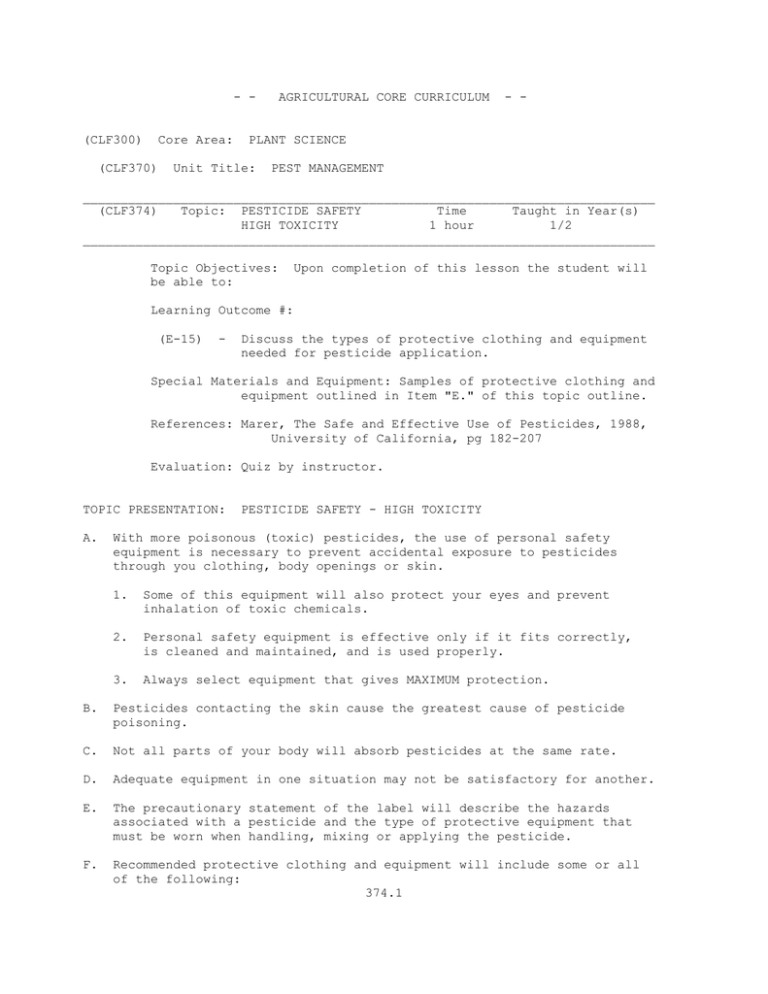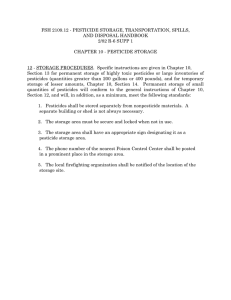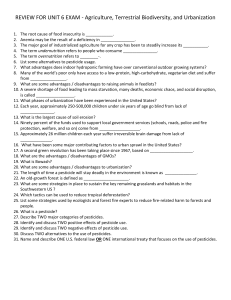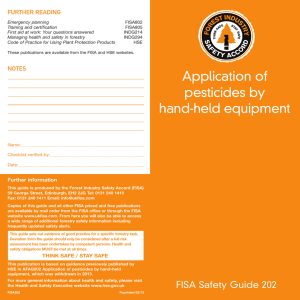CLF374
advertisement

- (CLF300) Core Area: (CLF370) AGRICULTURAL CORE CURRICULUM - - PLANT SCIENCE Unit Title: PEST MANAGEMENT ____________________________________________________________________________ (CLF374) Topic: PESTICIDE SAFETY Time Taught in Year(s) HIGH TOXICITY 1 hour 1/2 ____________________________________________________________________________ Topic Objectives: be able to: Upon completion of this lesson the student will Learning Outcome #: (E-15) - Discuss the types of protective clothing and equipment needed for pesticide application. Special Materials and Equipment: Samples of protective clothing and equipment outlined in Item "E." of this topic outline. References: Marer, The Safe and Effective Use of Pesticides, 1988, University of California, pg 182-207 Evaluation: Quiz by instructor. TOPIC PRESENTATION: A. PESTICIDE SAFETY - HIGH TOXICITY With more poisonous (toxic) pesticides, the use of personal safety equipment is necessary to prevent accidental exposure to pesticides through you clothing, body openings or skin. 1. Some of this equipment will also protect your eyes and prevent inhalation of toxic chemicals. 2. Personal safety equipment is effective only if it fits correctly, is cleaned and maintained, and is used properly. 3. Always select equipment that gives MAXIMUM protection. B. Pesticides contacting the skin cause the greatest cause of pesticide poisoning. C. Not all parts of your body will absorb pesticides at the same rate. D. Adequate equipment in one situation may not be satisfactory for another. E. The precautionary statement of the label will describe the hazards associated with a pesticide and the type of protective equipment that must be worn when handling, mixing or applying the pesticide. F. Recommended protective clothing and equipment will include some or all of the following: 374.1 G. 1. Waterproof apron made from rubber or synthetic material. 2. Waterproof boots or foot covering made of rubber or synthetic materials. 3. A daily change of coveralls or clean outer clothing. a. Wear waterproof pants and jackets if there is any chance of becoming wet with spray. b. Never wear cotton fabric without additional protective clothing when there is a chance of getting wet. 4. Faceshield, goggles or full face respirator (see 7 below). 5. Waterproof gloves:. a. must not have any type of absorption lining. b. should be made from rubber or synthetic material. 6. Waterproof, wide brimmed hat with a nonabsorptive headband. 7. Cartridge-type respirator. a. These include a fitted rubber facepiece and replaceable filters. b. They need to fit properly to be safe and effective. c. Be sure to have filters and cartridges on hand in case one needs to be replaced during use. For particular types of pesticide handling jobs such as in packaging them at the manufacturing plants require very special types of safety clothing and equipment are used. 1. These include powered air cartridge respirators and supplied air respirators. 2. Some of these would resemble the full body suits worn by scuba divers. __________________________________________________________ ACTIVITY: 1. Demonstrate the use of the various pieces of clothing and equipment discussed in this topic. 2. Ask a Qualified Applicator Licensee to speak to class about safety clothing, equipment and procedures. 3. If possible, have the applicator suit up for the class. __________________________________________________________ 374.2






